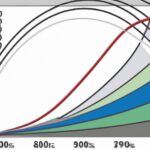Inflation is a broad concept, encompassing different types that impact economies worldwide. Demand-pull inflation occurs when consumer demand surpasses production capacity, driving prices up. Cost-push inflation results from increased business expenses being passed onto consumers. Built-in inflation involves wage increases leading to higher prices, creating a cycle of rising costs. Hyperinflation causes rapid and extreme price hikes, disrupting economic stability and eroding purchasing power. Structural inflation refers to persistent price increases due to underlying economic factors. Understanding these various types of inflation is crucial for policymakers and individuals alike to navigate and mitigate their effects on financial well-being and overall economic health.
Table of Contents
(Cost-push Inflation and Demand-pull Inflation)
Inflation can broadly be categorized into different types, each impacting the economy and individuals differently. The most common form is demand-pull inflation, caused by increased demand exceeding supply. Cost-push inflation arises from rising production costs passed on to consumers. Built-in inflation results from wage increases that companies offset by raising prices. Hyperinflation, an extreme form, causes prices to skyrocket rapidly, leading to economic instability. Core inflation, excluding volatile items such as food and energy, is used to gauge long-term price trends. Asset inflation occurs when the value of assets like real estate or stocks rises sharply. Deflation, the opposite of inflation, causes a general decrease in prices, often leading to economic stagnation. Stagflation combines stagnation with inflation, posing challenges for policymakers. Creeping inflation, characterized by slow and steady price increases, can erode purchasing power over time. Understanding these various types of inflation is crucial for policymakers and consumers to navigate economic uncertainties effectively.
Built-in inflation
Inflation is like that sneaky guest who overstays their welcome at a party. You think you’ve got everything under control until it starts to wreak havoc on your plans. Built-in inflation, unlike other forms of rising prices, lurks within the very structure of an economy like a hidden serpent waiting to strike.
Picture this: you work hard all year for that modest pay raise, only to find out it barely covers the increased cost of living. That’s built-in inflation in action! It happens when wages rise in response to price hikes, creating a never-ending cycle where workers demand more money as prices go up and businesses pass those costs along to consumers.
It’s a vicious dance between employers and employees where each move they make seems reasonable on its own but collectively drives inflation higher and squeezes everyone’s wallets tighter. Imagine being stuck in a maze with no way out – that’s how built-in inflation traps both individuals and entire economies.
The insidious nature of this phenomenon lies in its ability to become ingrained into society’s fabric without anyone noticing until it’s too late. Families budgeting every penny suddenly find themselves shortchanged by unseen forces manipulating their purchasing power from behind the scenes.
Think about it: parents working longer hours just to afford basic necessities while kids grow up seeing less of them each day – that emotional toll adds weight to the burden already borne by financial strain caused by built-in inflation. The stress mounts as dreams deferred pile up like unanswered wishes tossed into a well with no bottom in sight.
As time progresses, this silent thief erodes savings meant for rainy days, leaving families vulnerable when storms inevitably hit. Retirement plans crumble under the weight of diminished real value while hopes for future generations’ prosperity fade into uncertainty clouded by economic instability fueled by relentless built-in inflation cycles.
Breaking free from this invisible chain requires awareness and collective action aimed at disrupting established patterns fueling perpetual price increases through wage demands spiraling out of control unchecked over time—only then can societies hope truly outrun this shadow stalking their financial futures incessantly.
Cost-push inflation
Cost-push inflation occurs when the costs of production rise, causing businesses to pass on these increased expenses to consumers through higher prices. Imagine a scenario where the price of raw materials like steel and oil suddenly spikes. Manufacturers who rely on these materials find themselves grappling with elevated production costs. As a result, they are left with no choice but to raise the prices of their goods and services.
The impact of cost-push inflation can be felt across various sectors of the economy. Picture small business owners facing mounting pressure as they struggle to maintain profitability amidst soaring input costs. These individuals, filled with worry and uncertainty, must make tough decisions about whether to absorb losses or risk losing customers by increasing prices.
Moreover, consider how everyday consumers are affected by cost-push inflation. Visualize families carefully budgeting their monthly expenses only to find that groceries, fuel, and other essentials have become more expensive overnight. The frustration and helplessness experienced by these individuals paint a vivid picture of the challenges posed by rising inflation caused by external factors beyond their control.
In essence, cost-push inflation creates a ripple effect throughout the economy, impacting businesses large and small as well as ordinary citizens trying to make ends meet. It highlights the interconnected nature of markets and how changes in one area can trigger widespread repercussions.
When faced with this type of inflationary pressure, policymakers often find themselves at a crossroads. They must weigh the delicate balance between combating rising prices without stifling economic growth or inadvertently causing unemployment due to companies cutting back on hiring or even laying off workers.
Ultimately, navigating cost-push inflation requires a nuanced approach that considers both short-term solutions such as targeted subsidies or tax incentives for struggling industries along with long-term strategies aimed at enhancing productivity and reducing reliance on volatile inputs.
In conclusion, while cost-push inflation presents significant challenges for economies worldwide, it also underscores the resilience and adaptability required to weather unpredictable economic storms effectively.
Demand-pull inflation
Have you ever felt the pinch of rising prices, where it seems like everything on your shopping list keeps getting more expensive? That’s the essence of demand-pull inflation. Picture this – consumers are flocking to stores, wallets brimming with cash, eager to splash out on those trendy gadgets or sleek new cars. The sellers notice this surge in demand and decide they can hike up prices without losing customers.
In this dance between supply and demand, a delicate balance is disrupted. With everyone clamoring for the latest must-have items, manufacturers struggle to keep up. Raw materials become scarcer, workers need overtime pay for churning out goods at lightning speed – all leading to increased production costs that get passed down the line.
Imagine walking into a bustling market square where vendors shout their wares over each other in a bid for attention. It’s chaotic yet vibrant; the air crackles with energy as buyers jostle amidst stalls laden with goods. Now picture these scenes mirrored in an economy gripped by demand-pull inflation. Prices soar like kites cut loose from strings, floating higher and higher beyond reach.
As wallets grow thinner under the weight of escalating costs, families rethink their spending habits. Luxuries morph into unattainable dreams while necessities turn into budgeting battlegrounds. The once jovial chatter around dinner tables falters; anxiety creeps in alongside concerns about making ends meet.
Businesses find themselves at a crossroads too – do they raise prices further to cover burgeoning expenses or risk cutting back on staff and resources? In boardrooms filled with tension, decisions made today could reverberate through countless livelihoods tomorrow.
Demand-pull inflation isn’t just about numbers on graphs or percentages ticking upwards; it’s a story woven from threads of human desires and economic realities colliding head-on. Like waves crashing against cliffs eroded by time, its impact reshapes landscapes both personal and global.
So next time you feel that pang of disbelief at another price hike or shake your head at shrinking portions masked as discounts – remember you’re not alone in navigating these turbulent waters of demand-pull inflation.
(What are the different types of INFLATION?!)
Hyperinflation
Imagine waking up one morning, grabbing your wallet to buy a loaf of bread, only to find that the price has doubled from yesterday. This terrifying scenario is what hyperinflation brings – a rapid and uncontrollable increase in prices, leaving people scrambling to afford basic necessities.
Hyperinflation is like a wildfire raging through an economy, fueled by excessive money supply. It’s not just about prices going up; it’s about them skyrocketing at dizzying speeds. The once stable value of money evaporates into thin air, causing chaos and uncertainty for everyone.
In the midst of hyperinflation, the ordinary becomes extraordinary. A simple cup of coffee can cost you a week’s salary, and saving money in a bank account feels like watching it melt away with each passing day. As prices spiral out of control, businesses struggle to set prices that keep pace with inflation while consumers grapple with shrinking purchasing power.
Picture empty shelves in stores as suppliers can’t keep up with rising costs or demand. People rush to spend their money quickly before its value diminishes further – leading to hoarding goods instead of savings for tomorrow. Savings lose their meaning when cash is worth more burning fuel than sitting idly waiting for rainy days.
The psychological toll of hyperinflation is profound too – stress levels soar as individuals see their hard-earned money becoming worthless pieces of paper within weeks if not days. Trust in the currency erodes rapidly; confidence in government policies wanes; fear and uncertainty grip society as dreams turn into nightmares overnight.
History bears witness to harrowing tales where wheelbarrows were needed not for carrying groceries but stacks upon stacks of banknotes just enough for daily needs – illustrating how hyperinflation transforms ordinary life into a surreal dystopia where financial stability vanishes faster than shadows at dusk.
Amidst this economic maelstrom though lies resilience and adaptation – stories emerge of communities finding innovative ways to cope: bartering goods becomes common practice again; alternative currencies spring up like wildflowers after rain providing temporary relief from the storm brewing on conventional fronts.
But make no mistake: hyperinflation isn’t just an economic term thrown around by experts—it’s a lived experience etched deeply into the memories and pockets of those who endured its wrath firsthand—a reminder that vigilance against runaway inflation remains ever crucial in safeguarding our financial futures against such catastrophic uncertainties.
Stagflation
Stagflation is like a menacing storm on the economic horizon, blending two of the most unwanted guests in any financial forecast: inflation and stagnation. Imagine it as that unexpected guest at a party who ruins everyone’s fun – prices soaring high while growth slumps low. It’s an unholy matrimony of rising costs and sluggish productivity, creating a headache for policymakers worldwide.
When stagflation strikes, consumers feel the squeeze in their wallets as everyday goods become pricier while job opportunities dry up. The economy enters this bizarre state where everything seems to be going wrong simultaneously. Companies struggle to maintain profits amidst escalating expenses, leading to lay-offs and belt-tightening measures.
Think about walking along a winding road with potholes everywhere – that’s what navigating stagflation feels like for businesses trying to stay afloat amid turbulent waters of uncertainty.
Governments grapple with tough decisions during stagflation; do they raise interest rates to curb inflation risks or cut them to stimulate growth? It’s akin to being caught between Scylla and Charybdis – either choice bears consequences that can rock the boat further in troubled economic seas.
Picture an orchestra playing out of tune; that’s how central banks feel when trying to orchestrate monetary policies during stagflation. Each move carries weighty implications, risking worsening one aspect while attempting to salvage another.
The ordinary citizen becomes a casualty in this economic war zone – grappling with higher prices on essentials without commensurate wage increases or facing job insecurity due to companies battening down hatches against economic headwinds.
Navigating through stagflation requires deft hands and keen foresight from policymakers as they attempt delicate balancing acts between competing priorities – like trying not just walk but tap-dance gracefully on eggshells laid across shifting sands beneath their feet by tumultuous market forces.
As we sail through these choppy waters of stagflation, let’s remind ourselves that storms eventually pass, making way for calmer skies ahead. In the meantime, batten down those financial hatches and brace yourself for rough seas ahead – it may be rocky now, but smoother sailing could be just beyond the horizon if we weather this storm together!
External Links
- WHAT IS INFLATION and WHAT ARE THE TYPES OF INFLATION …
- Consumer Price Index Frequently Asked Questions : U.S. Bureau of …
- Prevailing Wage and the Inflation Reduction Act | U.S. Department of …
- Point targets, tolerance bands, or target ranges? Inflation target …
- What are some of the factors that contribute to a rise in inflation …













